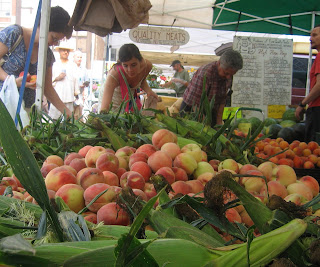
 The eggplant hails from tropical Southeast Asia, and it was in India where the plant began its cultivation as a pantry staple. The variety of shapes range from the familiar large globe to thin oblong to small egg-shaped ones – with a range of colors from the expected deep purple to white to pale green to a shocking Persian variety that is orange. The common denominator for this assortment of vegetable is that they should have a firm feel, and a smooth, unblemished skin when ripe. On most versions the smaller they are the less bitter they will taste, and the better the texture of its meat. I would prefer to buy two quarter-pound Italian globes than one half-pounder.
The eggplant hails from tropical Southeast Asia, and it was in India where the plant began its cultivation as a pantry staple. The variety of shapes range from the familiar large globe to thin oblong to small egg-shaped ones – with a range of colors from the expected deep purple to white to pale green to a shocking Persian variety that is orange. The common denominator for this assortment of vegetable is that they should have a firm feel, and a smooth, unblemished skin when ripe. On most versions the smaller they are the less bitter they will taste, and the better the texture of its meat. I would prefer to buy two quarter-pound Italian globes than one half-pounder. I personally, find the skin of the eggplant tough and bitter, and am apt to peel it away before I proceed with cooking them. The stubby Japanese ones and the small Thai egg-shaped ones maintain the exception to this rule for the former is prefect for stuffing, and the Thai ones are rather tender. Slicing and salting the eggplant before cooking helps leach out bitter compounds at technique that I perform regularly – particularly on larger sized purchases. If sautéing this vegetable be warned they will absorb about twice their volume of oil making them susceptible to sticking to your pan. In ancient Greece it was the patrician class that could afford cooking this vegetable.


Babaghnoush - yields 6 to 8 servings
3 pounds eggplant - medium size
3 garlic cloves – crushed to a paste
3/4 cup tahini paste
2 lemons – juiced (about 1/2 cup)
1 cup Italian parsley leaves – chopped
1/4 cup mint leaves –chopped
6 scallions - green tops only, chopped
1/4 cup extra virgin olive oil
Salt and freshly ground pepper to taste
Prick the eggplant with a fork on all sides. Place on a foil line baking tray, and place in a 350 degree oven. Let the eggplant bake till the skin is charred and blistered -- approximately 30 minutes. Turn the eggplant at least once to ensure that all sides blister. The eggplant will be soft and mushy when it’s done.
Let the eggplant cool slightly, then peel away the skin completely and discard. Discard the large strip of seeds that you will find in the center– a few remaining is fine. Place all the ingredients in a food processor and blend till smooth.

Eggplant in Balsamic
4 eggplants - approximately 2 pounds in total
1/4 cup chopped Italian parsley - leaves only
2 heads of garlic - roasted; skinned and pasted
2 teaspoons freshly ground black pepper
1 cup balsamic vinegar
1/2 cup extra virgin olive oil
Peel the skin and then slice the eggplant into 1/2" rounds, and grill or bake till cooked (approx. 8 minutes). Then in a 1-liter jar place the eggplant down flat. Combine the parsley, garlic and black pepper balsamic vinegar and olive oil together to form a smooth mixture. The eggplant should fit snugly in the jar. Pour the balsamic mixture over the eggplant, and cover with a non-metallic lid. You may want to drizzle some of the balsamic mixture between the layers of eggplant to ensure a good distribution of the flavors. Refrigerate for overnight to a few days before eating.
**To roast garlic trim the stem end of the garlic bulb to expose just the very top of the garlic. Drizzle the garlic bulb with 1 tablespoon of olive oil and wrap in aluminum foil. Place the garlic in a 350 degree preheated oven, and cook for 45 minutes. Let the garlic cool for 15 minutes and then squeeze the garlic out of the skin.



































